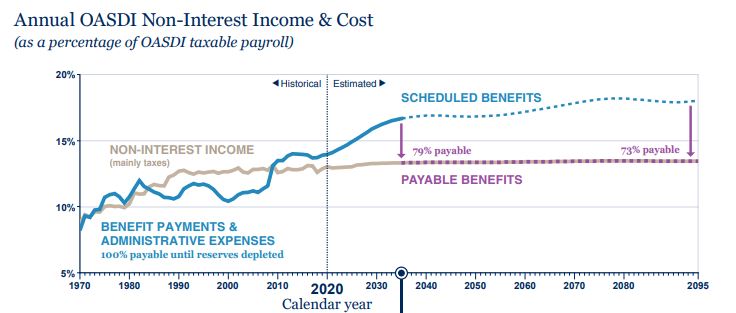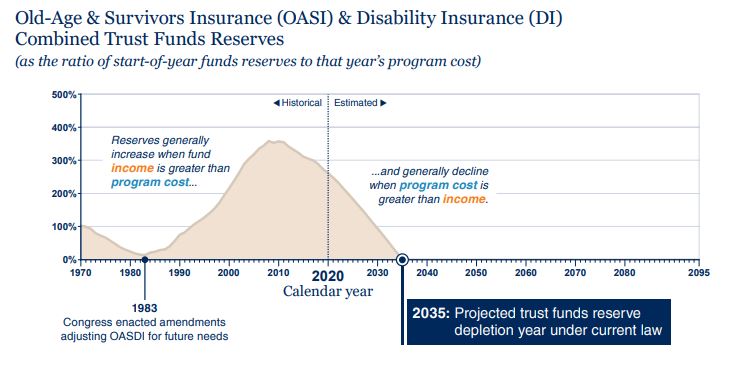The annual report from the Social Security Board of Trustees is a good gauge of the financial status of the funds that keep the program going, but this year’s report isn’t factoring one thing in when it comes to Social Security’s insolvency: the novel coronavirus pandemic.
“The duration and severity of the pandemic will affect the estimates presented in this year’s report and the financial status of the program.”
The asset reserves of the Old-Age and Survivors Insurance Trust and the Disability Insurance Trust are used to fund Social Security, and the 2020 report projects this money will be depleted by 2035, which means payouts will be reduced to 79% of what beneficiaries receive normally.
Here are some of the big takeaways regarding Social Security’s insolvency, per SSA press release:
- The asset reserves of the combined OASI and DI Trust Funds increased by $2.5 billion in 2019 to a total of $2.897 trillion.
- The total annual cost of the program is projected to exceed total annual income, for the first time since 1982, in 2021 and remain higher throughout the 75-year projection period. As a result, asset reserves are expected to decline during 2021. Social Security’s cost has exceeded its non-interest income since 2010.

- The year when the combined trust fund reserves are projected to become depleted, if Congress does not act before then, is 2035 — the same as last year’s projection. At that time, there would be sufficient income coming in to pay 79 percent of scheduled benefits.

But SSA Commissioner Andrew Saul noted that these Social Security insolvency projections weren’t taking into account the COVID-19 outbreak that has brought the economy to a halt and sent unemployment soaring above 22 million in a matter of weeks. If people aren’t working, they aren’t paying into the funds.
“The projections in this year’s report do not reflect the potential effects of the COVID-19 pandemic on the Social Security program,” Saul said. “Given the uncertainty associated with these impacts, the Trustees believe it is not possible to adjust estimates accurately at this time.”
Because Social Security relies so heavily on payroll taxes from working Americans for funding ($944 billion of the $1.062 income collected in 2019 came from payroll taxes), the total income brought in for 2020 will likely take a hit because over 20 million have been ejected from the job market. That’s a bad sign for Social Security’s insolvency.
“The duration and severity of the pandemic will affect the estimates presented in this year’s report and the financial status of the program, particularly in the short term,” Saul warned.
So while Social Security’s insolvency is still on track for 2035, there are some questions about how this crisis and the economic recovery going forward will change the program’s future.
Social Security will never go bankrupt, but a report like this shows how the benefits program could change in a major way if a funding solution isn’t found.
Many older Americans rely on Social Security as a major source of income in retirement, so an income cut of over 20% in less than 15 years would be a massive hit if the folks on Capitol Hill can’t figure out a solution.
• You can find all of the latest and most important news about Social Security here on Money & Markets.




